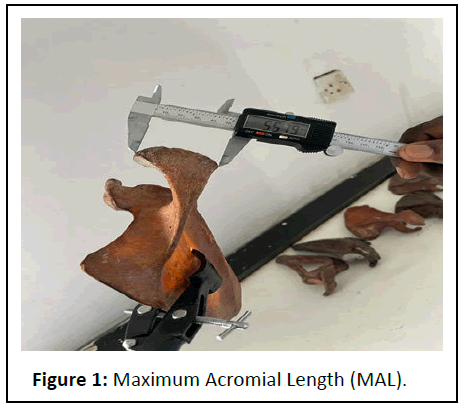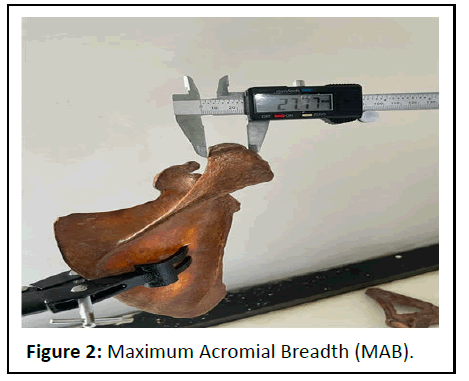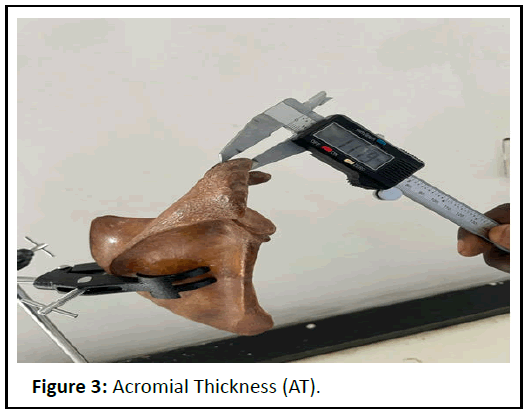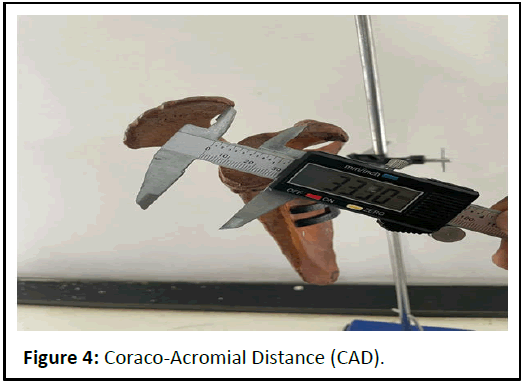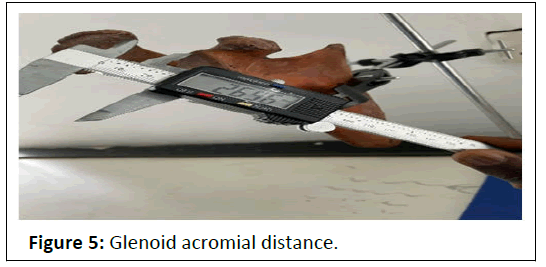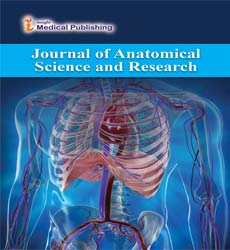Morphometric Study of the Acromion Process of Human Scapula in Nigerian Population
Bienonwu Emmanuel Osemeke1*, Benwoke Woroma Ibiwari2 and Adagbonyin Osahenrhumwen1
1Department of Anatomy, Igbinedion University Okada, Edo, Nigeria
2Department of Anatomy, Rivers State University of Science and Technology, Port Harcourt, Nigeria
- *Corresponding Author:
- Bienonwu Emmanuel Osemeke
Department of Anatomy,
Rivers State University of Science and Technology,
Port Harcourt,
Nigeria,
Tel: 08036263379;
E-mail: bienonwu.emmanuel@iuokada.edu.ng
Received date: May 29, 2023, Manuscript No. IPJASR-23-16842; Editor assigned date: June 01, 2023, PreQC No. IPJASR-23-16842 (PQ); Reviewed date: June 16, 2023, QC No. IPJASR-23-16842; Revised date: July 31, 2023, Manuscript No. IPJASR-23-16842 (R); Published date: August 08, 2023, DOI: 10.36648/IPJASR.6.1.007
Citation: Osemeke BE, Ibiwari BW, Osahenrhumwen A (2023) Morphometric Study of the Acromion Process of Human Scapula in Nigerian Population. J Anat Sci Res Vol:6 No:1
Abstract
The acromion is one of the processes of the scapula. Acromial morphology plays an important role in forensics and in orthopedics where it has a correlation with some shoulder pathology (shoulder impingement Syndrome). Scapular acromion has been classified into 3 types I, II and III, with the type I more prone to shoulder impingement syndrome. Acromion morphology has also been shown to differ between races. The aim of this study was to analyze morphometric values of the acromion in the right and left scapulae of Nigerians. The study involved a total of 215 dried scapula bones consisting of 105 right and 110 left obtained from anatomy departments of various universities in Nigeria. Acromial measurements were taken directly using a Vernier caliper. Data were expressed as mean ± standard deviation. T-test was used to compare mean values. Measurements were taken in millimeters. Parameters measured include: Acromial length, breadth, thickness, Coraco-acromial distance and glenoid acromial distance. The mean values obtained from this study for the right and left scapulae were: 44.32 ± 5.27 mm and 43.09 ± 5.15 mm, 24.25 ± 2.25 mm and 23.14 ± 2.35 mm, 7.60 ± -1.05 mm and 7.10 ± 1.15 mm, 40.05 ± 6.01 mm and 40.10 ± 7.20 mm, 30.05 ± 3.98 mm and 30.13 ± 4.02 mm, respectively. Biliteral differences and racial variation were recorded. The highest prevalence was recorded in type II acromion followed by types III and type I. The study showed that morphometry of the acromion plays a key role in forensics giving proper biological profiling for Nigerians and in orthopedics (clinical practice) in making precise evaluation of shoulder pathology.
Keywords
Acromion; Morphology; Scapula; Forensic; Orthopedics; Nigerian population
Introduction
The human scapula is a flat triangular bone located on the posterolateral aspect of the trunk. It has three processes: The coracoid, the spinous and the acromial process [1]. The acromial process or acromion has an articulation with the clavicle at the lateral end forming the acromioclavicular joint. The supraspinatus tendon passes beneath the process and the subacromial bursa separates them [2]. The morphometry of the acromion has a signi icant role in orthopedics, by having a correlation with some shoulder pathology such as shoulder impingement syndrome (acromial) leading to shoulder pain while abducting the glenohumeral joint [2-4]. Acromion has been classi ied into three types: Type I ( lat), type II (curved) and type III (hooked) [5]. Of these three classes of acromion type III (hooked) has been observed to be more prone to rotator cuff tears and shoulder impingement syndrome. This was attributed to the enthesophytes which are signi icantly more common in the type III acromial process. In type I and type IV acromial process the incidence of enthesophytes was very small and rotator cuff tears and shoulder impingement syndrome were uncommon [6,7]. Type III (hooked) has also been observed to be more prevalent in males while type 11 ( lat) more prevalent in females. Another classi ication type IV (concave) was proposed [8]. But this classi ication has been observed to be uncommon and has no known correlation with rotator cuff pathology hence its unacceptability. Studies has also suggested that type 111 acromial process (hooked) could be a degenerative process as it showed a positive correlation with age [9]. Each individual presents with anatomical variations in shoulder anatomy and hence the need to study acromial morphology since it has a correlation with shoulder pathology. This will enable clinicians make precise evaluation of shoulder pathology [10]. Also, in forensics where racial variation has been established in bones as seen in this study with the acromion. Racial identi ication is still one of the most difficult areas of skeletal identi ication [11]. This has an implication in prosthetics and could lead to mismatched prosthesis if not taken into consideration and also in other anthropometric applications. It is well known that Asian sub population are smaller with shorter stature compared to their Caucasian counterparts it follows that these discrepancies may give rise to implant size mismatch with the resected bony surfaces of Nigerian patients since most of these prosthetic components are imported from the west based on their own morphometry [12-15]. The aim of this study was to record and analyze morphometric values of the acromion in Nigerians.
Materials and Methods
Two hundred and i teen (215) dried scapula bones consisting of 105 right and 110 le t were used. The bones were obtained from museums in anatomy departments of selected universities in Nigeria. Bones which have undergone degenerative changes were exempted from this study on gross inspection. All measurements were taken with a Vernier caliper. A pair of dividers was also used to con irm the measurements at its point and measured with a calibrated ruler. Each measurement was repeated twice and the mean value was recorded. Measurements were taken in millimeters. The following ive (5) morphometric parameters were measured (Figures 1-5).
Maximum Acromial Length (MAL): Measured from the tip of the acromion process up to the acromial angle.
Maximum Acromial Breadth (MAB): Measured across the middle of the acromion from the lateral aspect to the acromion to its medial side.
Acromial Thickness (AT): Measured along the lateral edge at three di erent points-one at the anterior end of acromion, second at the middle of the acromion and third near the posterior end of the acromion process. The average of these three measurements was taken as thickness of the acromion process.
Coraco-Acromial Distance (CAD): Measured as the distance between the tip of the acromion process and the tip of the coracoid process.
Supra Glenoid tubercle to Acromion process Distance (GAD): Measured as the distance between the supra glenoid tubercle and the tip of the acromion process.
The three acromial types based on shape were classified by observation in to; type I (flat), type II (curved) and type III (hooked) (Figure 6). Data obtained were analyzed using SPSS version 20.0 and results were presented in tables and descriptive statistics like percentage mean and standard deviation and student t-test and z-test were used.
Results
The results are presented in Tables 1-4.
| Parameters | Right. N=105 | Left. N=110 | ||||
|---|---|---|---|---|---|---|
| Mean ± SD | Min | Max | Mean ± SD | Min | Max | |
| Maximum Acromial Length (MAL) mm | 44.32 ± 5.27 | 23.94 | 56.32 | 43.09 ± 5.15 | 28.46 | 53.2 |
| Maximum Acromial Breadth (MAB) mm | 24.25 ± 2.25 | 17.8 | 33.62 | 23.14 ± 2.35 | 17.62 | 30.84 |
| Acromial Thickness (AT) mm | 7.61 ± 1.05 | 5.01 | 9.94 | 7.10 ± 1.15 | 4.36 | 10.2 |
| Coraco-Acromial Distance (CAD) mm | 40.05 ± 6.01 | 25.4 | 57.69 | 40.10 ± 7.22 | 23.98 | 62.1 |
| Supra Glenoid tubercle to Acromion process Distance (GAD) mm | 30.05 ± 3.98 | 22.2 | 39.8 | 30.13 ± 4.01 | 19.32 | 41.85 |
Table 1: Mean values and standard deviation of right and left scapula parameters.
| Parameters | Right. N=105 | Left. N=105 | p-value | Inference |
|---|---|---|---|---|
| Mean ± SD | Mean ± SD | |||
| Maximum Acromial Length (MAL) mm | 44.32 ± 5.27 | 43.09 ± 5.15 | 0.042 | Significant |
| Maximum Acromial Breadth (MAB) mm | 24.25 ± 2.25 | 23.14 ± 2.35 | 0.045 | Significant |
| Acromial Thickness (AT) mm | 7.61 ± 1.05 | 7.10 ± 1.15 | 0.0003 | Significant |
| Coraco Acromial Distance (CAD) mm | 40.05 ± 6.01 | 40.10 ± 7.22 | 0.92 | Insignificant |
| Supra Glenoid tubercle to Acromion process Distance (GAD) mm | 30.05 ± 3.98 | 30.13 ± 4.01 | 0.95 | Insignificant |
Table 2: Test of significance between mean values of right and left scapula parameters.
| Types | Right. N=105 | Left. N=110 |
|---|---|---|
| Type of acromion | Type of acromion | |
| Straight or flat | 9 | 10 |
| Percentage % | 8.50% | 9.10% |
| Curved | 79 | 90 |
| Percerntage % | 75.20% | 81.20% |
| Hooked | 17 | 10 |
| Percentage % | 16.20% | 9.20% |
Table 3: Frequency and percentage distribution of acromial types of right and left scapula.
| Parameters | Mean ± SD | Population | Authors |
|---|---|---|---|
| Maximum Acromial Length (MAL) mm | 46.46 ± 0.47 | Nepalese | Mansur, et al. |
| 46.40 ± 0.52 | Indians | Jaskaran, et al. | |
| 69.12 ± 3.69 | Chileans | Collipal, et al. | |
| 43.80 ± 5.20 | Present study | ||
| Maximum Acromial Breadth (MAB) mm | 26.63 ± 0.22 | Nepalese | Mansur, et al. |
| 23.40 ± 0.27 | Indians | Jaskaran, et al. | |
| 25.17 ± 3.69 | Chileans | Collipal, et al. | |
| 23.70 ± 2.20 | Present study | ||
| Acromial Thickness (AT) mm | Nepalese | Mansur, et al. | |
| 6.60 ± 0.11 | Indians | Jaskaran, et al. | |
| 8.73 ± 1.87 | Chileans | Collipal, et al. | |
| 7.35 ± 1.04 | Present study | ||
| Coraco- Acromial Distance (CAD) mm | 26.63 ± 0.50 | Nepalese | Mansur, et al. |
| 37.10 ± 0.55 | Indians | Jaskaran, et al. | |
| 39.76 ± 4.38 | Chileans | Collipal, et al. | |
| 40.10 ± 6.02 | Present study | ||
| Supra Glenoid tubercle to acromion process Distance (GAD) mm | 31.00 ± 3.07 | Nepalese | Mansur, et al. |
| 26.60 ± 0.44 | Indians | Jaskaran, et al. | |
| 28.24 ± 4.80 | Chileans | Collipal, et al. | |
| 30.25 ± 4.05 | Present study |
Table 4: Comparison of parameters of the acromion process of human scapula in Nigerian population with data on previous studies.
From Table 1, the Maximum Acromial Length (MAL) mm, Maximum Acromial Breadth (MAB) mm and Acromial Thickness (AT) mm was 44.32 ± 5.25 mm, 24.25 ± 2.25 mm and 7.61 ± 1.06 mm for the right and 43.09 ± 5.15 mm, 23.14 ± 2.35 mm, 7.10 ± 1.15 mm for the left side respectively (Table 1). There was a significant difference between sides (right and left) in these three parameters (p<0.05).
The mean measurements for the Coraco Acromial Distance (CAD) mm and Supra Glenoid tubercle to Acromion process Distance (GAD) mm was 40.05 ± 6.01, 30.05 ± 3.98 for the right and 40.10 ± 7.22, 30.13 ± 4.01 for the left respectively. There was no significant difference between sides (right and left) in these two parameters (p>0.05) (Table 2). The curved acromion showed the highest prevalence (75.2% and 81.2%) for the right and left sides respectively followed by the hooked acromion (16.2% and 9.2%) respectively for the right and left. The flat acromion showed the least prevalence with 8.5% and 9.1% for the right and left sides respectively (Table 3).
The Maximum Acromial Length (MAL) also showed significant differences (p<0.05) when compared with those of Nepalese, Indians and Chileans [16-18].
The Maximum Acromial Breadth (MAB) showed significant difference when compared with Nepalese 16 and Indians 17 (p<0.05) but not with that of Chileans. Also, the Acromial Thickness (AT) showed signi icant difference when compared with those of Indians and Chileans.
The Coraco Acromial Distance (CAD) mm showed significant difference with those of Indians 17 and Nepalese 16 so as the Supra Glenoid tubercle to Acromion process Distance (GAD) mm but further with the Chileans.
Discussion
The Maximum Acromial Length (MAL) mm, Maximum Acromial Breadth (MAB) mm and Acromial Thickness (AT) mm showed significant side differences (p<0.05) in this study. Their values were 44.32 ± 5.25 mm, 24.25 ± 2.25 mm and 7.61 ± 1.06 mm for the right and 43.09 ± 5.15 mm, 23.14 ± 2.35 mm. This may have implications in reconstructive surgery involving the shoulder joint where the contralateral healthy side cannot be used for pre-operative templating [19,20].
The Coraco Acromial Distance (CAD) mm and Supra Glenoid tubercle to Acromion process Distance (GAD) mm however showed no side differences (p>0.05). Their values were 40.05 ± 6.01, 30.05 ± 3.98 for the right and 40.10 ± 7.22, 30.13 ± 4.01 for the left respectively, implying that the contralateral healthy side can be used for pre-operative templating.
Racial variation is seen in the Maximum Acromial Length (MAL) mm between those of Nigerians and those of Nepalese, Indians and Chileans. The value for this study in general was 43.80 ± 5.20 as against 46.46 ± 0.47, 46.40 ± 0.52 and 69.12 ± 3.69 for the Nepalese, Indians and Chileans. This has significant implications in forensics where proper identification is key in profiling as well as in prosthetics where accurate sizing of prosthetic components is vital to the success of any reconstructive procedure. The Maximum Acromial Breadth (MAB) mm showed racial differences with those of Nepalese and Chileans but showed similarities with that of Indians. The value for this study in general was 23.70 ± 2.20 as against 26.63 ± 0.22, 25.17 ± 3.69 and 23.40 ± 0.27 for Nepales, Chileans and Indians respectively. The Acromial Thickness (AT) mm of this study disagrees with that of Indians and Chileans as it showed Variations. The value for this study in general was 7.35 ± 1.04 as against 6.60 ± 0.11 and 8.73 ± 1.87 for Indians and Chileans respectively.
The Coraco Acromial Distance (CAD) mm in this study was 40.10 ± 6.02 in general this agrees with those of Chileans which recorded 39.76 ± 4.38 but showed variations with those of Indians and Nepalese recording 37.10 ± 0.55 and 26.63 ± 0.50 respectively.
The Supra Glenoid tubercle to Acromion process Distance (GAD) mm showed variations with those of Chileans and Indians but agrees with that of Nepalese. The value recorded for this study in general was 30.25 ± 4.05 as against 28.24 ± 4.80, 26.60 ± 0.44 and 31.00 ± 3.07 for the Chileans, Indians and Chileans. These racial variations may be due to genetics and environmental make up a fact to be considered in the design of shoulder prosthesis and in racial identification in forensics.
The percentage prevalence of acromion types recorded in the study where type II-curved acromion was most prevalent followed by type III-hooked acromion and type I-flat acromion being the least prevalent agrees with that of other studies Bigliani, et al. Collipal, et al., Coskum, et al., Schetino, et al.
Acromion types have been associated with some clinical conditions such as subacromial impingment syndrome and it is suggested that a hooked form of scapulae acromion is more prone to this condition Yukio, et al.
Conclusion
The morphometric parameters of the acromion of human scapulae has significant clinical and forensic implications. In surgical intervention of the shoulder where accurate sizing of component is key to a successful procedure. Also, in medico legal cases where identification is key to solving most mystery deaths especially in Africa. The acromion parameters from this study provides biological profiling for the Nigerian population in order to solve the issuer of identity.
References
- Vinay GS, Sheela (2017) Morphometric study of the acromion process of scapula and its clinical importance in south Indian population. Int J Anat Res 5:4361-4364
- Edelson JG, Taitz C (1992) Anatomy of the coraco-acromial arch. Relation to degeneration of the acromion. J Bone Joint Surg Br 74:589–594
[Crossref] [Google Scholar] [PubMed]
- Bigliani LU, Ticker JB, Flatow EL, Soslowsky LJ, Mow VC (1991) The relationship of acromial architecture to rotator cuff disease. Clin Sports Med 10:823-838
[Crossref] [Google Scholar] [PubMed]
- Iliev AG, Georgiev P, Dimitrov D, Yordanova P, Landzhov B (2017) An anatomic study of the types of glenoid notch and their distribution among the genders. Chr J Clin Case Rep 1:010
- Bigliani LU, Morrison DS, April EW (1986) The morphology of the acromion and its relationship to rotator cuff tears. Orthop Trans 10:228
- Natsis KP, Tsikaras T, Totlis I, Gigis P, Skandalakis HJ, et al. (2007) Correlation between the four types of acromion and the existence of enthesophytes: A study on 423 dried scapulas and review of the literature. Clin Anat 20:267-272
[Crossref] [Google Scholar] [PubMed]
- Nweke CI, Oladipo GS, Alabi A (2017) Osteometry of acromion process of adult Nigerians: Clinical and forensic implications. J Appl Biotechnol Bioeng 2:25-30
- Farley TE, Neumann CH, Steinbach LS, Petersen SA (1994) The coracoacromial arch: MR evaluation and correlation with rotator cuff pathology. Skeletal Radiol 23:641–645
[Crossref] [Google Scholar] [PubMed]
- Ikemoto RY, Bezerra AD, Monte FA, Telles RB, Fujiki EN, et al. (2005) Hook-shaped acromion: an anatomical variation or a degenerative process? Rev Bras Orthop 40:454-463
- Warner JJ, Deng XH, Warren RF, Torzilli PA (1992) Static capsuloligamentous restraints to superior-inferior translation of the glenohumeral joint. Am J Sports Med 20:675-685
[Crossref] [Google Scholar] [PubMed]
- Bienonwu EO, Benwoke WI, Okwuonu UC, Omotoso DR (2020) Osteometric morphometry of the proximal Tibia end in Nigerian population. Int J Applied Res 6:117-123
- Urabe K, Mahoney OM, Mabuchi K, Itoman M (2008) Morphologic differences of the distal femur between Caucasian and Japanese women. J OrthopSurg 16:312-315
- Vaidya SV, Ranawat CS, Aroojis A, Laud NS (2000) Anthropometric measurements to design total knee prostheses for the Indian population. J Arthroplasty 15:79-85
[Crossref] [Google Scholar] [PubMed]
- Bae DK, Park JY (2000) The study of anatomical measurement of proximal tibia and fitness of tibial prosthesis in total knee arthroplasty. J Korean Orthop Assoc 35:57-64
- Giles E, Elliot O (1963) Gender determination by discriminant function analysis of crania. Am J Phys Anthropol 21:53-58.
[Crossref] [Google Scholar] [PubMed]
- Singh J, Pahuja K, Agarwal R (2013) Morphometric parameters of the acromion process in adult human scapulae. Int J Basic Appl Med Sci 2:1165-1170
- Mansur DI, Khanal K, Haque MK, Sharma K (2012) Morphometry of acromionprocess of human scapulae and its clinical importance amongst Nepalese population. Kathmandu Univ Med J (KUMJ) 10:33-36
[Crossref] [Google Scholar] [PubMed]
- Collipal E, Silva H, Ortega L, Espinoza E, Martinez C (2010) The Acromion and its different forms. Int J Morphol 28:1189-1192
[Crossref] [Google Scholar] [PubMed]
- Bienonwu EO, Fawhehimi HB, Olotu EJ, Ihunwo IW (2017) Gender and bilateral differences of femoral condyle morphology of Nigerians. An Osteometric Study. Anat Sci J 8:159-165
- Coskun N, Karaali K, Cevikol C, Demirel BM, Sindel M (2006) Anatomical basics and variations of the scapula in Turkish adults. Saudi Med J 27:1320-1325
[Google Scholar] [Pubmed]
- Schetino LP, Sousa Junior RR, Amancio GP, Schetino MA, Almeida-Leite CM, et al. (2013) Anatomical variations of acromions in Brazilian adult’s scapulas. J Morphol Sci 30:98-102
Open Access Journals
- Aquaculture & Veterinary Science
- Chemistry & Chemical Sciences
- Clinical Sciences
- Engineering
- General Science
- Genetics & Molecular Biology
- Health Care & Nursing
- Immunology & Microbiology
- Materials Science
- Mathematics & Physics
- Medical Sciences
- Neurology & Psychiatry
- Oncology & Cancer Science
- Pharmaceutical Sciences
